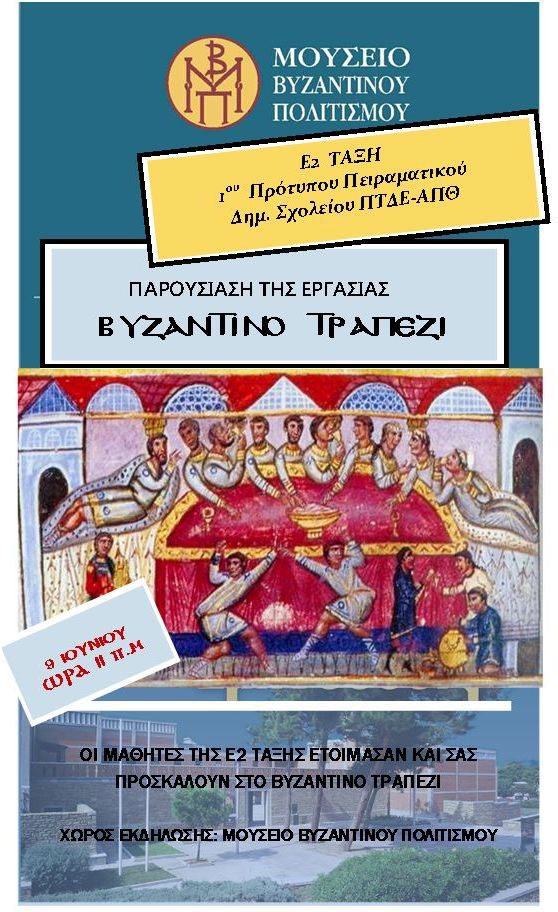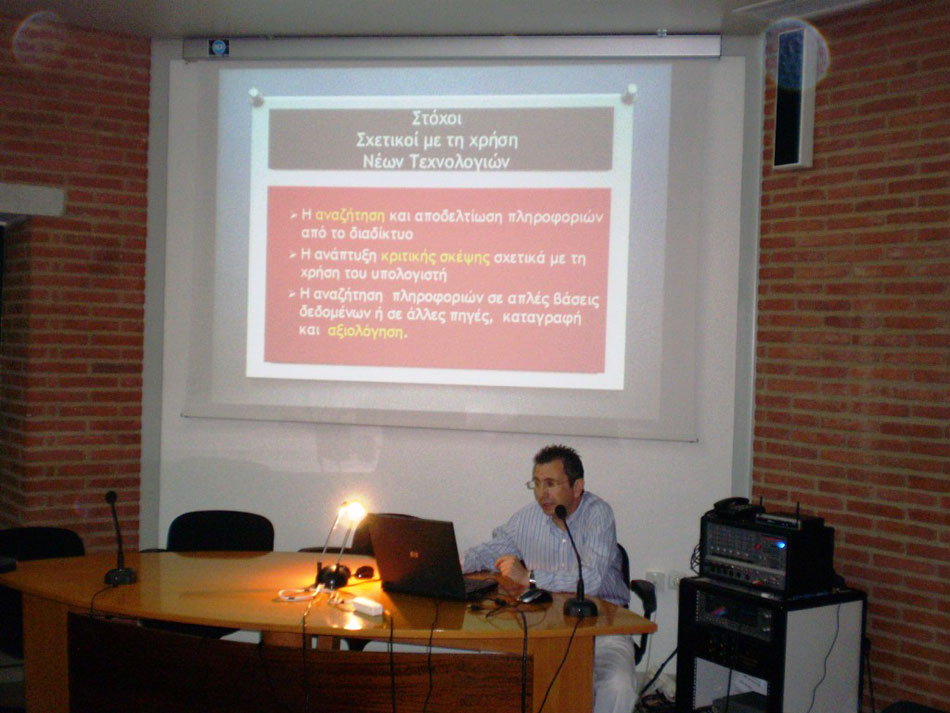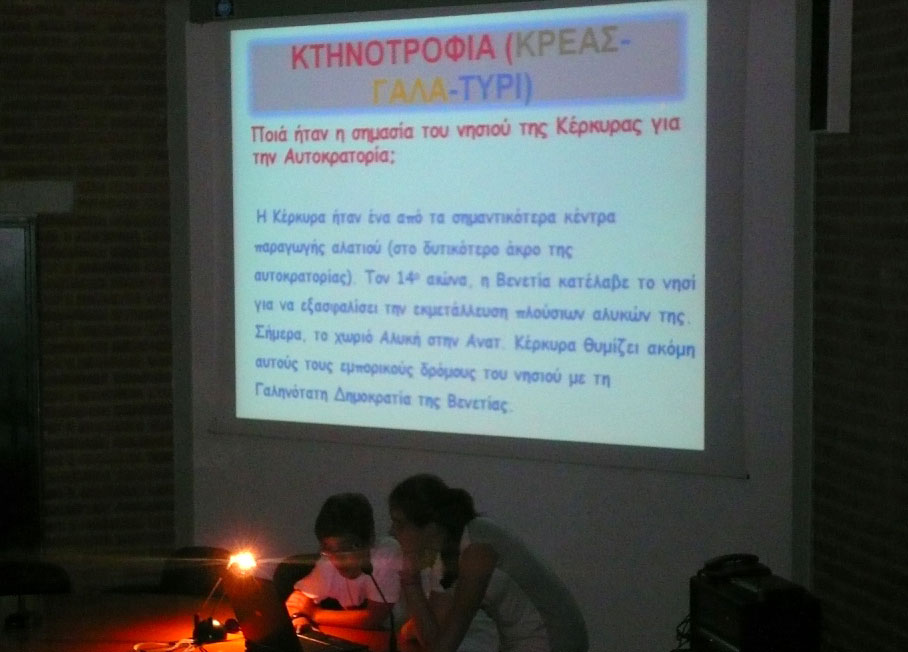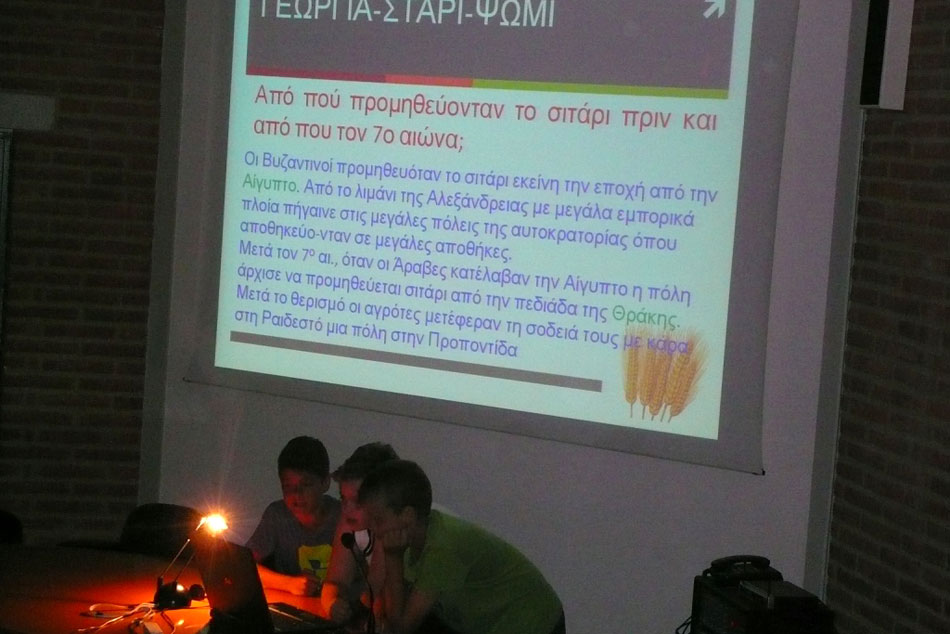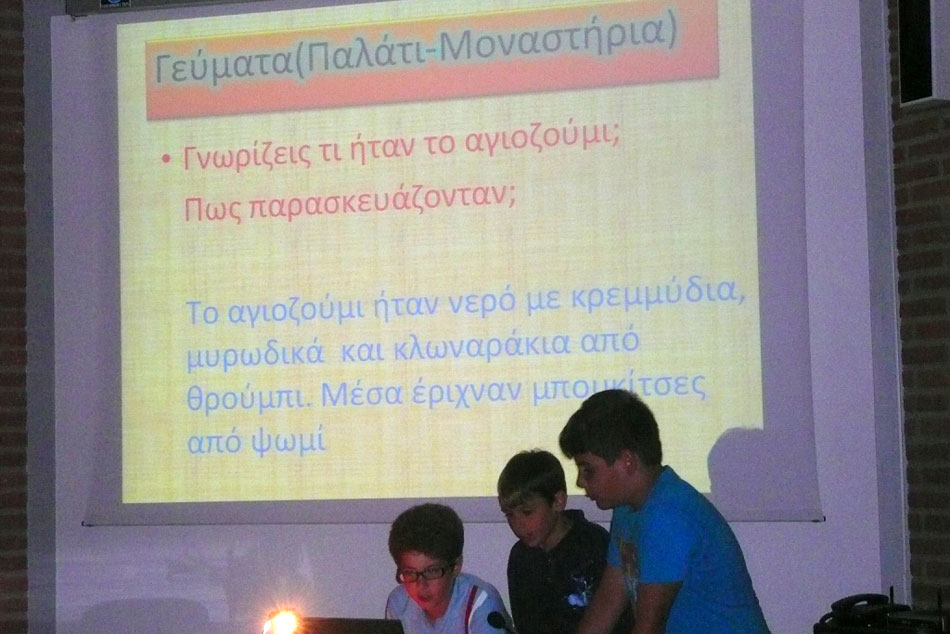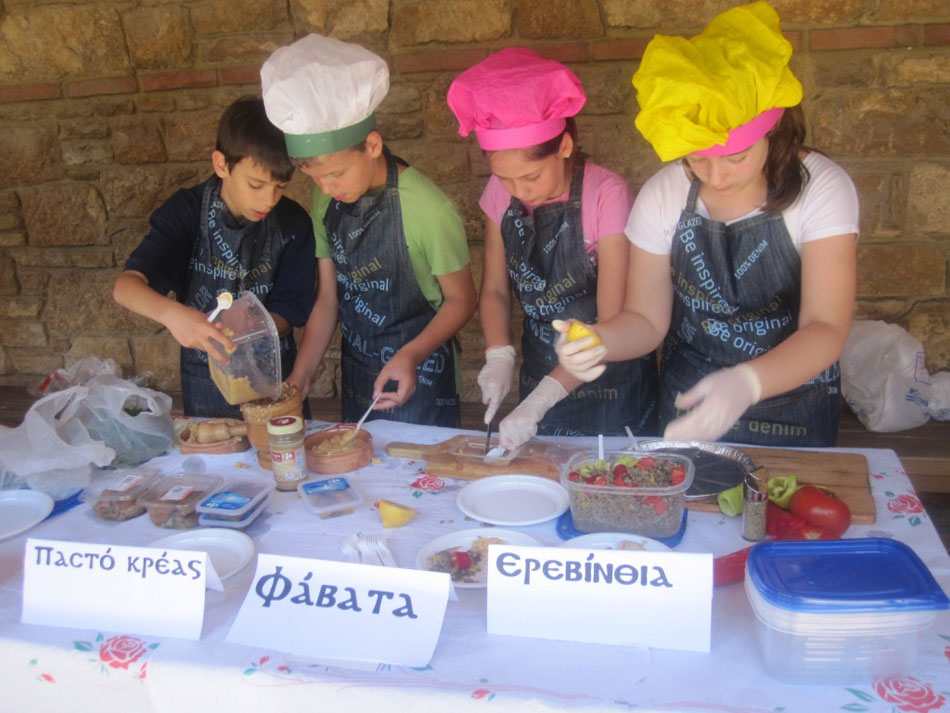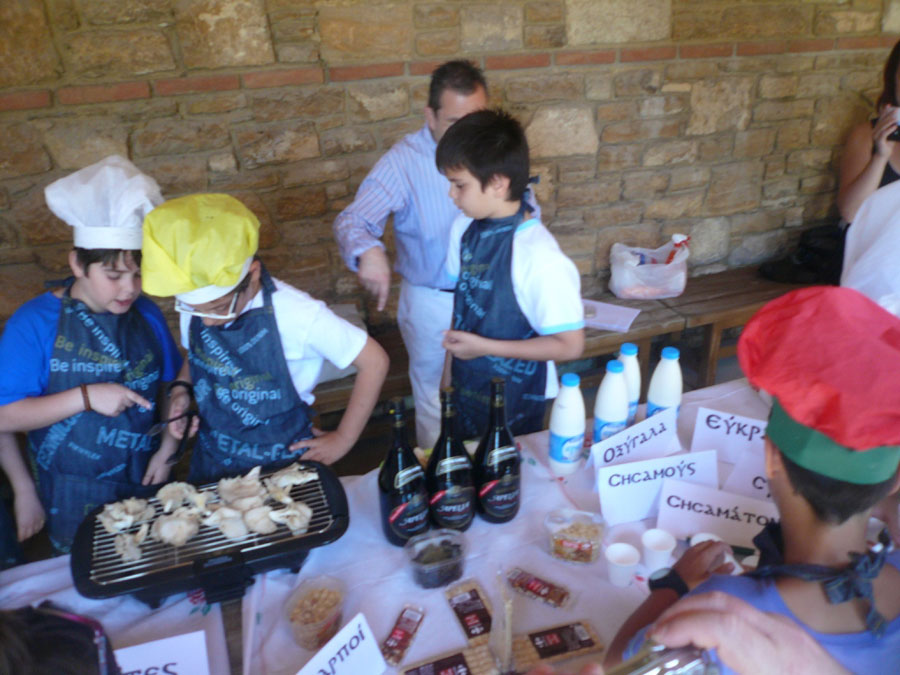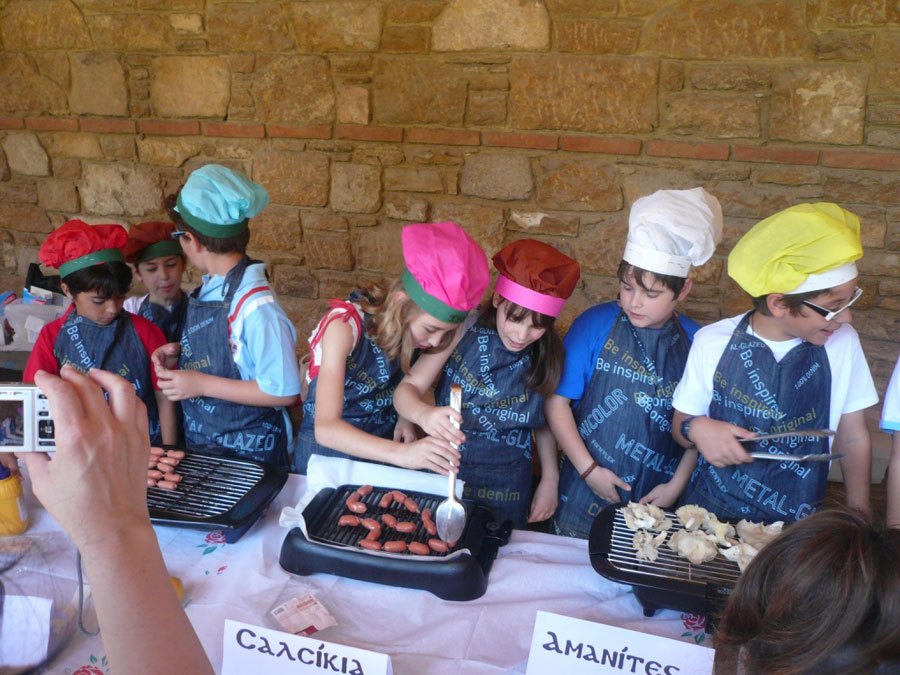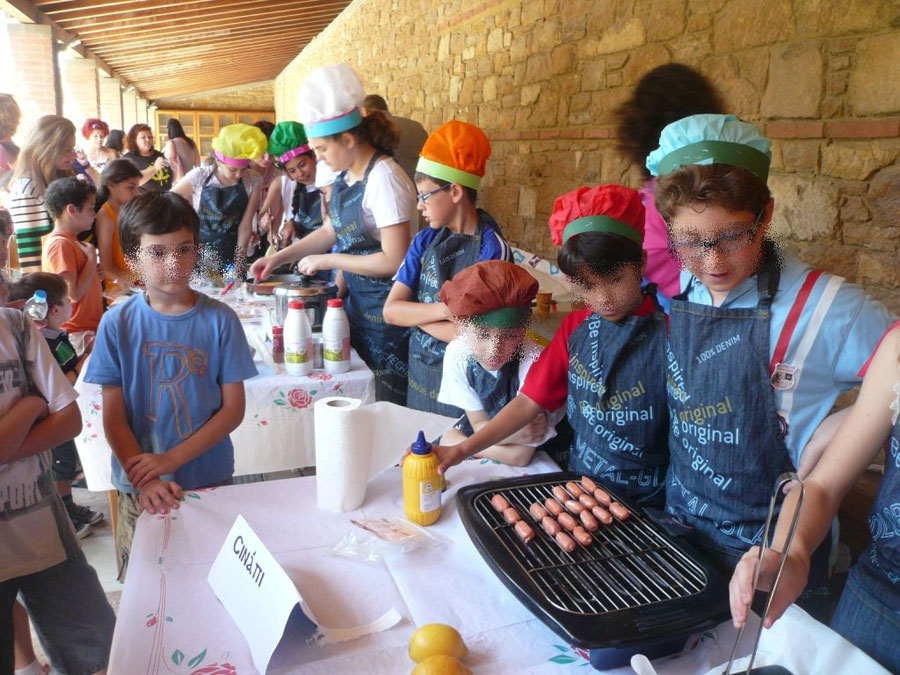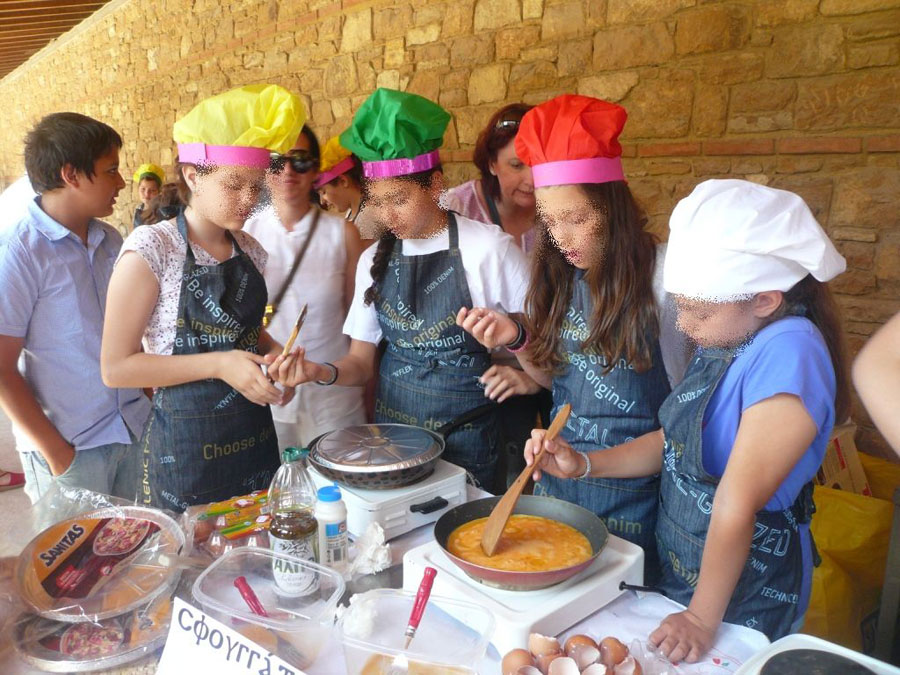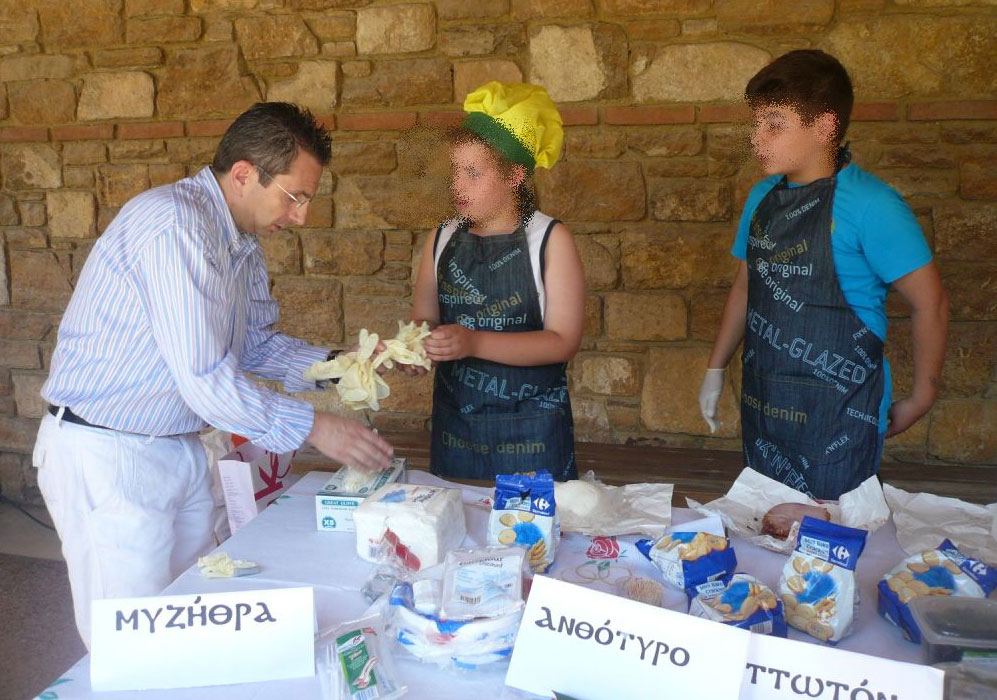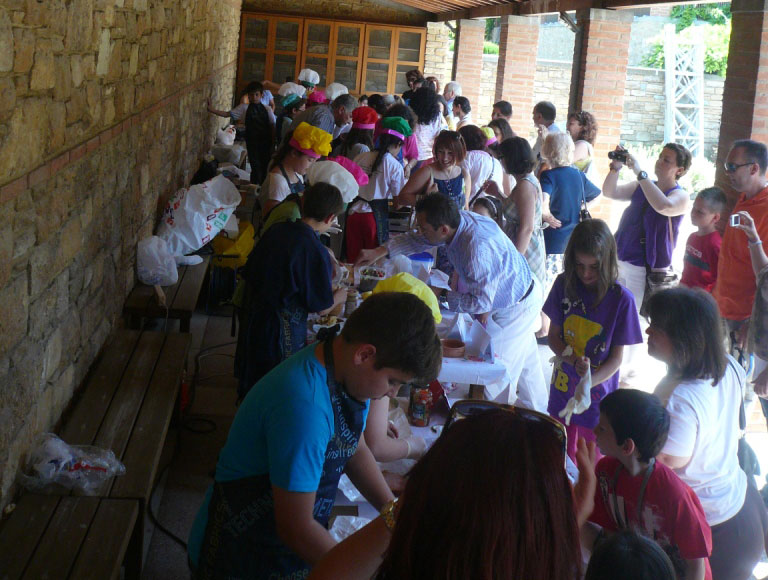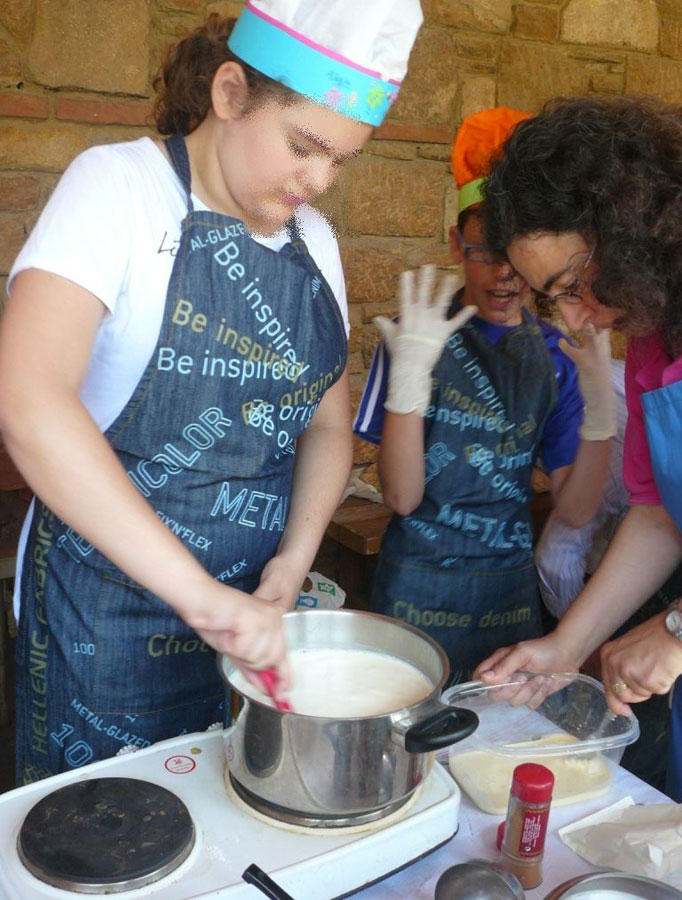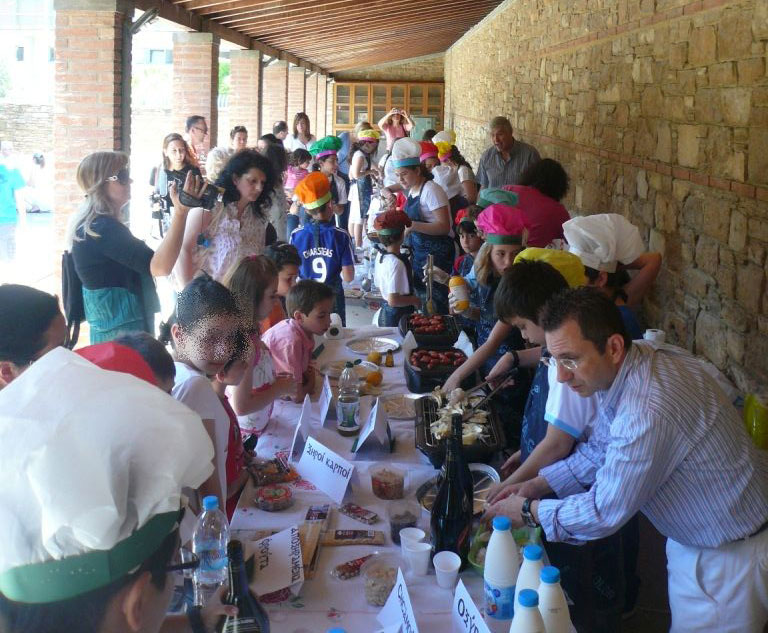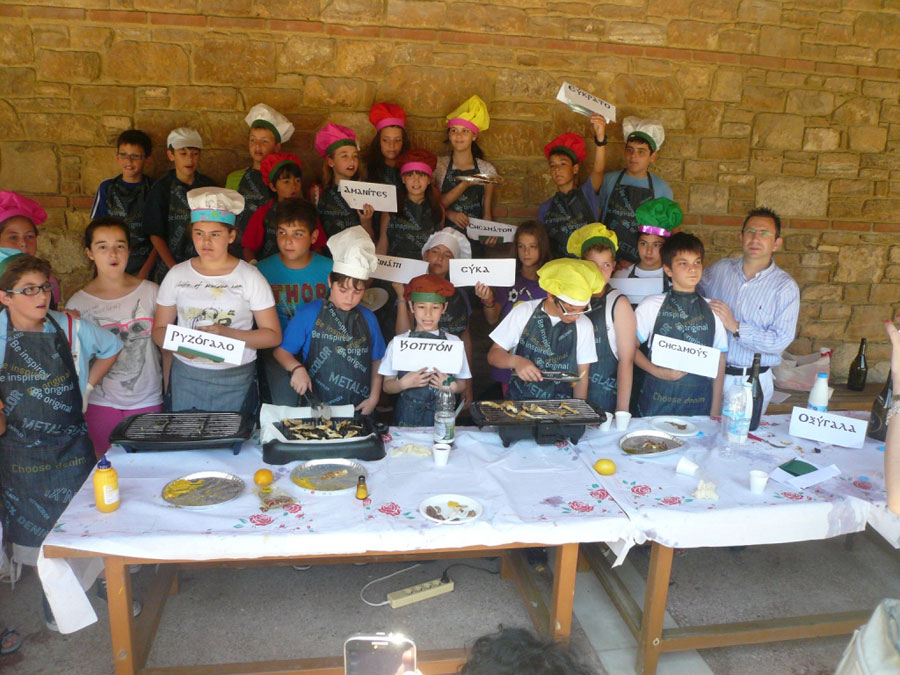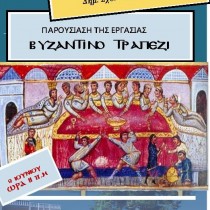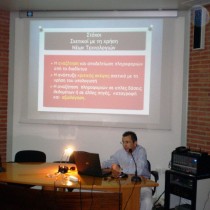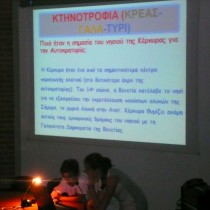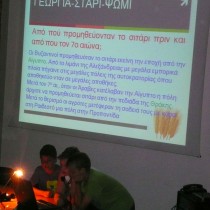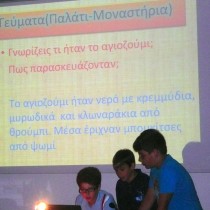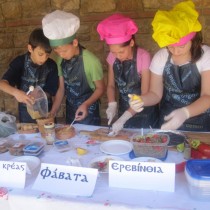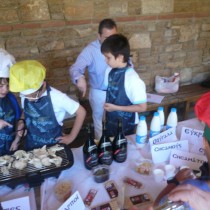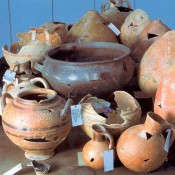Often, children ask the question “what and how did the ancient Greeks and Byzantines eat?”, which has been answered at a scientific level in the two preceding articles of this special issue. This fact led to the planning of two projects based on modern museum connected educational trends relying on the “learning by doing” method and assisted by Information and Communication Technology.
Roughly 30 years ago, round 1985, in a first attempt at directly linking culture to education, the Ministry of Culture founded the Department of Educational Programmes and Communication and a committee for museum education was set up by the Greek Section of the ICOM. In the decade to follow, the Ministry of Education and the Ministry of Culture established, in a similar spirit, the programme named MELINA to further educate teachers on art and culture, to produce educational material and to design and carry out educational activities (note 1). Nobody would have guessed the impact these initiatives were to have on the students themselves especially when they started to make use of the potential in the Information and Communication Technologies (ICT).
Naturally, this impact was to have repercussions on the new educational views on the manner of approaching, presenting and analyzing the subject taught. Among other things, these methods should aim at pleasure through learning, to promote creativity and to improve communication skills at all levels, an issue that has been discussed in very many books and conferences. According to educational views of today (note 2), teaching is a process whereby the instructor’s proper actions and the creation of necessary conditions and prerequisites provide the student with the opportunity not only to receive knowledge but also to produce it himself. In this context, the transmission of knowledge by the teacher is not abolished, but other roles are added to his, one of which is to support the student in both mastering the bulk of information, judging and using it creatively. This is in accordance with the “theory of social structuralism” (note 3) where emphasis is placed on discussion in which students explore a topic in depth, exchange points of view, look into the topic’s meanings and repercussions while studying its various aspects. Together with the discussion structured and directed by the teacher, an important part is played by collaborative learning in which students work together in groups. The theory includes methods and teaching practices that all give the student opportunities to play and to take initiative in handling objects as well as taking part in activities that encourage him/her to research, analyze and process information and stimuli. These opportunities do not just enrich his/her knowledge on specific topics but also stimulate his/her curiosity and help develop general strategies that allow him/her to “learn how to learn”. This was the logic on which the projects “the byzantine table” and “the Ancient Greek table” were based and for which the “learning by doing” method was put to use.
“Learning by doing” (note 4) is defined as a process of acquiring knowledge through experience and the search for a personal meaning in the latter. Thus, the personal development of “the learners” is promoted at the same time as well as their awareness in social problems and issues concerning human relationships. Theorists of Critical Education (note 5) believe that if the students can acquire confidence in their ability to learn, they acquire greater control of their life and can then begin to steer their activities towards social change. It becomes clear that “learning by doing” presupposes the active participation of students in activities such as research, field work, observation, simulation, creative compositions et al., reaching the limits of exploratory learning as well as methods such as problem solving and the “project” (note 6).
New Technologies (NT), come to support “learning by doing”, and their exploitation, both as the object but also as the means of teaching, have, among others, the following objectives: “the students will actively participate in the educational process through teaching methods that motivate their wish to learn. The NT provide increased possibilities in this direction and therefore incorporating them in the educational process is a component of this strategy” (note 7). Indeed, according to the Curriculum the use of the ICT serves extra objectives regarding the learning of individual subjects, as for example: supporting students in their research, helping problem solving and the development of critical thinking, supporting activities such as expression through symbols, communication and the search for information.
The two projects called “the Byzantine table” and “the Ancient Greek table” were designed taking into consideration all the above, and a detailed description of them can be read below.
Concept- Objectives
The projects were realized in two classes of the 1st Experimental Primary School PTDE-AUT; the first in class E2 (2011 to 2012) and the second (combined with the project “Dress in Antiquity”) in class D2 (2013-2014). At the start of the 2011-2012 school year P. Kourtis, a primary school teacher in class 2 of the 5th grade, had the idea of carrying out a project that would combine multiple aims both cognitive, educational and related to Information and Communication Technologies (ICT), also putting to use the “learning by doing” method. The archaeologist and museum educator M. Girtzi was asked to scientifically back the project and she then collaborated in the choice of topic (nutrition in Byzantium), and in realizing all the stages of the work.
Given the huge success of the “Byzantine table” project, at the start of the 2013-2014 school year we, P. Kourtis and M. Girtzi decided to realize a similar project on Ancient Greek nutrition and dress for the primary school students of class 2 of the fourth grade.
The cognitive-educational goals set were common to both projects. On the one hand, they were concerned with the structuring of primary historical concepts such as:
-Examining cause and effect, detecting motivation
-Understanding the concept of time and its continuity
-Correlating historical events
-Searching for elements of everyday life from earlier historical periods
-Cultivating historical thought and research processes with the use of written and material historical evidence.
-Direct access to knowledge coming from different sources and by searching the web.
On the other hand, these goals were concerned with a more specific use of the “learning by doing” method and the new technologies (NT), such as:
-Stressing that history is not just historical events
-Making the students interested in the daily life of people in earlier times
-Emphasising Greece’s continuity through nutrition and tradition
-Using sources, their cross referencing and synthesis
-Familiarizing the students with the terminology of history and helping them acquire the corresponding vocabulary
-Teaching history in general differently.
Phases of the “Byzantine table” project
At the end of December 2011, the teacher P. Kourtis and the archaeologist and museum educator M.Girtzi had their first meeting where, for a start, the topic was decided as well as the parts of the project. Byzantine nutrition was thought to be generally interesting for research and would also interest the students as a topic, as well as being adequately referred to in both printed and electronic sources some of which are specially written for children. In the next meeting it was decided how the necessary material and sources were to be gathered and selected.
The second meeting took place in mid January. It was decided to use the following sources:
1. Αναγνωστάκης, Η. (1998). Βυζαντινών διατροφή και μαγειρείες, special issue in ΕΠΤΑ ΗΜΕΡΕΣ of «Η Καθημερινή» newspaper.
2. Καλαμάρας, Π. (2010). «Οι διατροφικές συνήθειες των Βυζαντινών», Αρχαιολογία και Τέχνες journal, issue 116, pp. 1-17.
3. Στάμπογλη, Ε. (2002). Πρόσκληση σε γεύμα, in the series «Στους δρόμους του Βυζαντίου», i. 1, εκδόσεις Καλειδοσκόπιο: Αthens.
4. TalbotRice, T. (1980). Ο δημόσιος και ιδιωτικός βίος των Βυζαντινών, εκδόσεις Δ.Ν. Παπαδήμα: Αthens.
5. Walter, G. (2007). Η καθημερινή ζωή στο Βυζάντιο, εκδόσεις Δ.Ν. Παπαδήμα: Αthens.
6. «Βρώματα και Μαγειρείες», essay of the Educational Programmes office of the Byzantine Museum.
7. Βυζαντινών Διατροφή και Μαγειρείαι, (2005). Minutes of the one day conference «Περί της διατροφής στο Βυζάντιο», Ministry of Culture, Archaeological Resources Fund (TAPA), Αthens.
Of course, the only elements chosen from the above sources were the ones serving the goals decided in the initial planning. The obstacle of a multiple simultaneous reading and research from the sources by the students was now easily tackled with the help of technology. Those sources existing in printed form would be digitalized so as to be simultaneously accessible. Moreover, teamwork was chosen as the students’ method of work. It was decided to divide them into 7 groups (6 groups of 3 and one of 4). Each group would have a different topic to research and any basic information found would be recorded on a worksheet. The topics were:
-Fishing-fish-seafood
-Livestock-meat-milk-cheese
-Agriculture-wheat-bread
-Agriculture-fruit-vegetables-olive oil-wine
-Utensils (palace-monasteries-everyday)
-Meals (palace-monasteries-everyday)
-Marketplace-customs-space-furniture.
The sources were digitalized as pdf files. Then e-books were created so the students could choose the form they preferred for their research. Two weblogs were created for the sources: http://byzantinotrapezi.wordpress.com/ (with pdf files) and http://byzantino-trapezi.blogspot.gr/ (with e-books). In addition, the work sheets were set up through which the research would be guided. These each contained 10 to 15 questions, depending on their length. Up to three sources would have to be researched in order to answer these questions. In more than one sheet there were some identical questions, either because they were considered very important or because we wanted to observe the teams’ different perspective on the same topic.
The students were first introduced to the topic in mid February when an in class presentation was made of the nutritional customs of the past. This totally served its purpose as it captured the students’ imagination and aroused their interest to a great extent. Consequently, when announced, they enthusiastically accepted their first mission: they were to go search on the web, record and then present topics related to peoples’ diet during the Byzantine era. Here it should be noted that the subject matter in the primary school’s fifth grade History book is the Byzantine period.
Next the students were divided into teams and given the work sheets. The manner of work was explained to them; research would take place on computers in the school’s Information workshop. All information was in the two blogs already on line. The questions were to be answered and written down in an ordinary notebook and then the material was to be changed to digital form (word) and finally a presentation was to be created. Below are some indicative questions from the work sheets:
-What types of fish were eaten?
-Describe how the fishing was done.
-By what means, in what areas and which time of year?
-What were people paid in that era?
-What was the cost of olive oil, fish and meat?
-What were the kinds of bread at that time? Which of them exist today?
-What is pepper bread and what do you know about it?
-What vegetables were grown?
-What was eaten during fasting?
-What cooking utensils were used in the monasteries?
-Describe the utensils from a royal table
-What were “tsoukes” and how were they made? Are they used today?
-Describe the ritual of a monastery meal.
-If you lived in those times what beverage would you offer to your friends?
-What were their desserts? Do they exist today and with what name?
The first phase, which was the finding, analysing, comparing and recording lasted 10 two hour teaching sessions, while the second i.e. the preparing of the presentation lasted 3. The problems that came up were very few, the most important one being the difficulty in the collaboration of members from two teams. Also, some teams found it difficult to search for information from a second or third source, believing this to be unnecessary. The teams showed their presentations to all the class in a total of 4 two hour teaching sessions. Criticism was made in class concerning more technical issues i.e. the manner of presentation, clarity, understanding and the completeness of the slides as well as how that was achieved by the students. The most fundamental part of the research followed, which was discussion on the content presented. Initially, words and terms were explained and the way of life of the people of that period was commented on. Next, a comparison was made with today regarding the type of diet, the means that were used but also a general look at eating habits. Last, the children’s projects were uploaded on the blogs to be accessible to everyone.
In the initial plan, the idea had been to present the project to a wider audience of peers, parents and teachers as well as carrying out a “learning by doing” activity given the right conditions. The Museum of Byzantine Culture of Thessaloniki was looked into as the most appropriate place to present the project. To our great joy permission was granted for the event as well as support from E. Fourlinga and I. Gavrielidou, two members of the research faculty in the department of Educational Programmes. Our event was in two parts and took place on Saturday, June 9th 2012. The first part was held in the amphitheatre of the MBCT where the projects were presented. The students were quite relaxed with the public and presented their arguments with ease. Part two-learning by doing- was the cooking done by all the children of dishes that, according to the sources, were eaten in the Byzantine era. In the courtyard of the MBCT’s department of educational programmes, the children prepared some of the recipes, chosen from the sources studied, for their parents and visitors to the museum. Specifically, the following food was cooked and served up by the students of class 2 of grade 5: “myttoton” (finely chopped garlic cloves, olive oil and olive paste) on “paxama/rusks”, olives either “thlastes” (crushed) or “throumbates” (savory), “erevinthia favata” (chickpea fava) and “faki vrekti”(lentils with fresh vegetables), salted fish and meat, “amanites epsetoi” (grilled mushrooms), “salsikia peseta” (grilled sausages), “sfoungato” (omelette), “anthotyro” (type of cream cheese) and “myzethra” (type of soft white cheese), “orygala” (rice pudding), “sesamous” (sesame and honey sweet), “oinos eukratos” (wine diluted in water), “oxygala” (sour milk).
In this manner, the children really “experienced a day in the time of Byzantium” and savoured “Byzantine cuisine” to which they successfully initiated both their parents and all the visitors!
Maria Girtzi, Archaeologist
Paraskevas Kourtis, Teacher
